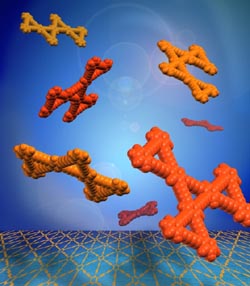Home > Press > Carbon-rich molecules "supersized" for the first time
Abstract:
The giant superstructures permit researchers to test predictions of usefulness for synthetic carbon
Carbon-rich molecules "supersized" for the first time
Eugene, OR | Posted on December 02, 2005
A University of Oregon chemist has "supersized"
carbon-rich molecules, enabling researchers for the first time to test
theories about the useful properties of synthetic forms of carbon. The
discovery by Mike Haley will be published as the cover story in the Dec.
9 edition of the Journal of Organic Chemistry (JOC). The story will be
posted on the JOC website today (Dec. 2).

Artist's conception of chemistry professor Mike Haley's "supersized" carbon-rich molecules. Image credit: Annie Tykwinski.
|
Scientists have long predicted that unnatural forms of carbon could have
many technologically useful properties, much like those found for the
natural phases of carbon, which are graphite and diamond. Haley's
research seeks to prove those predictions are true and to do so, the new
carbon materials must be of sufficient size to observe their properties.
"'Supersizing' fragments of unnatural carbon has enormous implications
for determining future applications because certain properties can only
be realized at much larger dimensions," said Haley. At a diameter of
five to six nanometers (a nanometer is a billionth of a meter) the new
disk-shaped molecules are more than twice the size of the one-to-two
nanometer pieces previously developed by Haley's team. For instance,
Haley explains that molecules of polystyrene used for Styrofoam cups are
rigid because of their large size. At much smaller molecule sizes,
however, the same material is a viscous liquid. "Size is important," he
said.
Haley and doctoral student Jeremiah Marsden were able to produce several
different supersized molecules by using acetylene subunits to link
benzene anchors to form the giant networks. The expanded molecules have
a high density of pi-electrons that are extremely useful for electronics
and optics. Haley said the most promising application for the new
material is in optical electronics and, specifically, switches used in
telecommunications. Haley's group is collaborating with researchers at
the University of Michigan to test the strength, reliability, and
durability of the new material.
Mike Haley is a professor of chemistry and a member of the university's
Materials Science Institute. His research was funded by a grant from the
National Science Foundation.
Mike Haley
541-346-0456
Haley@uoregon.edu
Contact:
Kathy Madison
541-346-3145
kmadison@uoregon.edu
Links:
Mike Haley Webpage
The Journal of Organic Chemistry
Carbon Networks Based on Dehydrobenzoannulenes
Copyright © University of Oregon
If you have a comment, please Contact us.
Issuers of news releases, not 7th Wave, Inc. or Nanotechnology Now, are solely responsible for the accuracy of the content.
| Related News Press |
Possible Futures
![]() Discovery points path to flash-like memory for storing qubits: Rice find could hasten development of nonvolatile quantum memory April 5th, 2024
Discovery points path to flash-like memory for storing qubits: Rice find could hasten development of nonvolatile quantum memory April 5th, 2024
![]() With VECSELs towards the quantum internet Fraunhofer: IAF achieves record output power with VECSEL for quantum frequency converters April 5th, 2024
With VECSELs towards the quantum internet Fraunhofer: IAF achieves record output power with VECSEL for quantum frequency converters April 5th, 2024
Materials/Metamaterials/Magnetoresistance
![]() Nanoscale CL thermometry with lanthanide-doped heavy-metal oxide in TEM March 8th, 2024
Nanoscale CL thermometry with lanthanide-doped heavy-metal oxide in TEM March 8th, 2024
![]() Focused ion beam technology: A single tool for a wide range of applications January 12th, 2024
Focused ion beam technology: A single tool for a wide range of applications January 12th, 2024
Announcements
![]() NRL charters Navy’s quantum inertial navigation path to reduce drift April 5th, 2024
NRL charters Navy’s quantum inertial navigation path to reduce drift April 5th, 2024
![]() Discovery points path to flash-like memory for storing qubits: Rice find could hasten development of nonvolatile quantum memory April 5th, 2024
Discovery points path to flash-like memory for storing qubits: Rice find could hasten development of nonvolatile quantum memory April 5th, 2024
|
|
||
|
|
||
| The latest news from around the world, FREE | ||
|
|
||
|
|
||
| Premium Products | ||
|
|
||
|
Only the news you want to read!
Learn More |
||
|
|
||
|
Full-service, expert consulting
Learn More |
||
|
|
||








